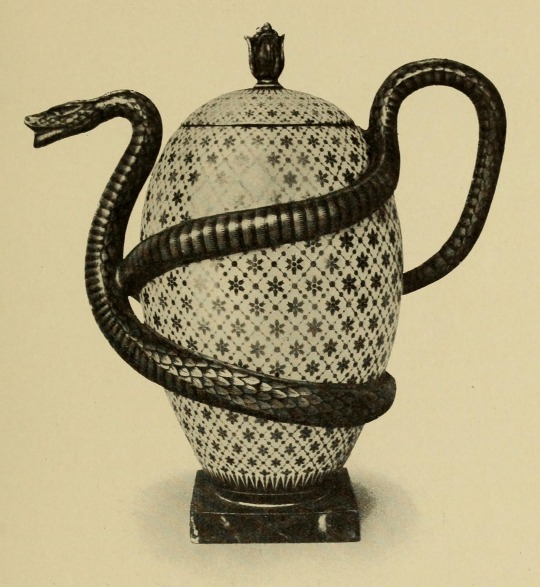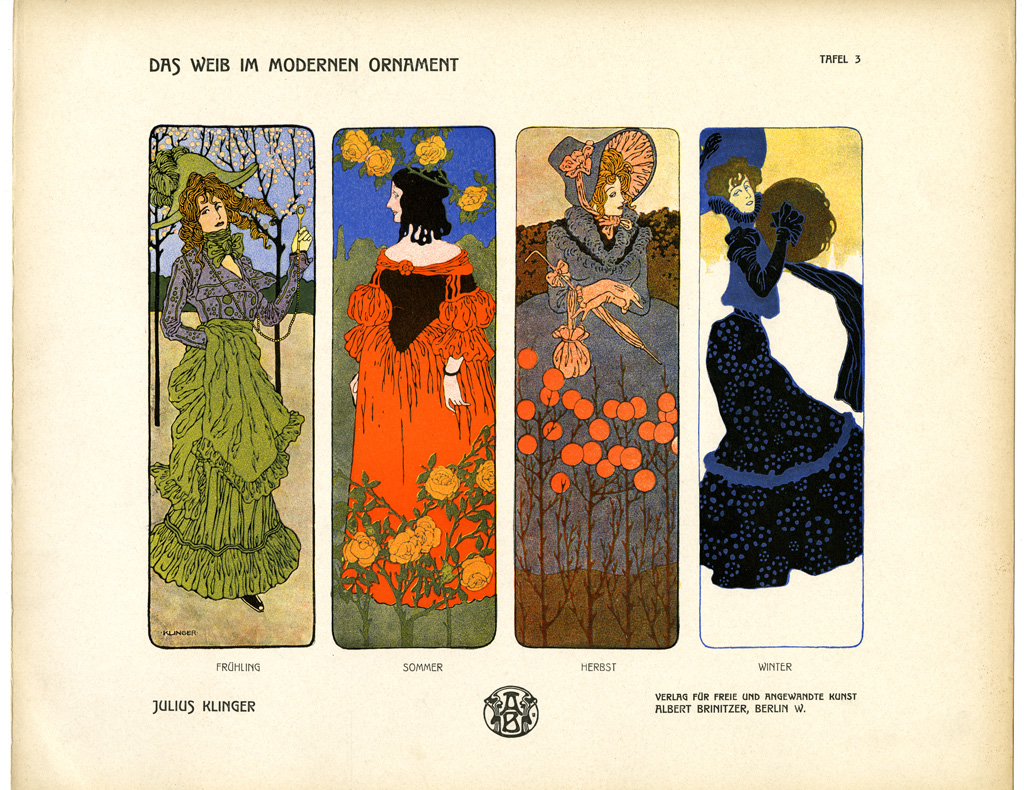#Kunstgewerbe
Explore tagged Tumblr posts
Text
TIMELESS SILVER: Schwäbisch Gmünd bis 10.04.2023
TIMELESS SILVER: Schwäbisch Gmünd bis 10.04.2023
Silber – das weiße, helle und spiegelnde Metall gehört seit beinahe 150 Jahren zur DNA des Gmünder Museums im Prediger. 1876 von den ansässigen Silberfabrikanten nach dem Konzept des Londoner Victoria and Albert Museum gegründet, ist das Gmünder Museum die älteste kunstgewerbliche Vorbildersammlung im deutschen Südwesten. Seitdem zählt, ganz im Sinne der Gründerväter, das Sammeln von gut…

View On WordPress
#Bronze#Edelmetalle#Emaille#Genius Loci#Gold#Handwerkskunst#Kunstgewerbe#Kunsthandwerk#Löffel#Messing#Museum im Prediger#Schwäbisch Gmünd#Silber#Tafelsilber#Timeless Silver
1 note
·
View note
Photo

Naturstudien für Kunst u. Kunstgewerbe - Paul Flanderky - 1902 - via University of Heidelberg
172 notes
·
View notes
Photo

A French jug with a snake handle deemed to be “in bad taste” by the author of Guter und schlechter Geschmack im Kunstgewerbe (Pazaurek, 1912), which translates to “Good and bad taste in arts and crafts.” The author writes: “[The jug] shows a particularly nonsensical construction, in which the spout and handle are formed by the same snake, apparently wrapped around it.”
Full text available here.
2K notes
·
View notes
Text

Max Bill Holding a Class at the Art School Kunstgewerbe-Schule in Zurich
29 notes
·
View notes
Text
1890s Needlework Books
More links can be found at my Blogspot.
de Dillmont, Thérèse. Encyclopedia of Needlework. Mulhouse: Brustlein & Co., 1890. Dombach, Paul. Das Posamentier-Kunstgewerbe: Gründliche Anleitung zur Herstellung sämmtlicher Möbelposamenten. Dresden: E. Tretbar, 1894. Hapgood, Olive C. School Needlework: A Course of Study in Sewing designed for use in Schools. Boston, MA: Ginn & Company, 1893. Heron, Addie E. Ladies' Work for Pleasure and Profit. Chicago, IL: The Home Manual Company, 1894. Perkins, George C., comp. A Treatise on Embroidery, Crochet and Knitting. New York, NY: M. Heminway & Sons Silk Co., 1899. —. Art Needlework. Philadelphia, PA: The Brainerd & Armstrong Company, 1893. —. Dainty Work for Pleasure and Profit. [Unknown], 1893. —. Florence Home Needle-Work, Vol. 5. Florence, MA: Nonotuck Silk Company, 1891. —. Florence Home Needle-Work, Vol. 6. Florence, MA: Nonotuck Silk Company, 1892. —. Florence Home Needle-Work, Vol. 7. Florence, MA: Nonotuck Silk Company, 1893. —. Florence Home Needle-Work, Vol. 8. Florence, MA: Nonotuck Silk Company, 1894. —. Florence Home Needle-Work, Vol. 9. Florence, MA: Nonotuck Silk Company, 1895. —. Florence Home Needle-Work, Vol. 10. Florence, MA: Nonotuck Silk Company, 1896.
60 notes
·
View notes
Text

Art Nouveau Ginkgo designs: brooches, hangers, hatpins
by Else Strauss, student of Kunstgewerbeschule Strasbourg
In: "Das Kunstgewerbe in Elsass-Lothringen" (The Arts and Crafts in Alsace-Lorraine), 6.1905/06, S.132
source
73 notes
·
View notes
Photo

Vishnu & Lakshmi sitting on Sesh-Naag Sometimes Radha Krishna are depicted too considering as Vatar of Lord Vishnu.illustration from Maurice Dupont, Kunstgewerbe der Hindu,1924
82 notes
·
View notes
Video
Das Weib im modernen Ornament (Woman in Modern Ornamentation), Tafel 3: Frühling / Sommer / Herbst / Winter (Spring / Summer / Autumn / Winter) by MCAD Library Via Flickr: Julius Klinger (Austrian graphic designer, 1876-1942) 1902 color lithographs 32.5 cm (height) x 39.5 cm (width) Scanned from Klinger, Julius. Das Weib im modernen Ornament: ein Vorlagenwerk fur alle Gebriete des Kunstgewerbes Teil I. Berlin: Albert Brinitzer, Verlag fur Freie und Angewandte Kunst, n.d. See MCAD Library's catalog record for this book. intranet.mcad.edu/library
#MCAD#MCAD Library#MCAD Special Collection#Julius Klinger#Das Weib im modernen Ornament#Woman in Modern Ornamentation#color lithographs#Plants in art#Fruit in art#Decoration and ornament#Seasons in art#Women in art#Flowers in art#flickr#spring#winter#summer#fall#rose#roses#rosa#apple blossoms#cherry blossoms#prunus#fruit#art nouveau
3 notes
·
View notes
Text













Blaudruckhandwerke in Ungarn
Ottó Domonkos
Corvina, Budapest 1981, 124 pages, 20x26,15 cm
euro 35,00
email if you want to buy [email protected]
“Mit der Wiederentdeckung der klaren Farben und Formen der Volkskunst erleben gegenwärtig auch die Blaudrucktextilien eine Renaissance. Außer für Stücke des täglichen Gebrauchs finden sie auch als elegante Damen- und Herrenbekleidung erneut Verwendung, so wie seinerzeit, im 17. Jahrhundert, als durch den Seehandel mit Indien zum erstenmal Blaudrucke als Geschenk an den französischen Königshof gelangten. Indische Baumwolle und Indigo wurden in Europa schnell bekannt. Nach der Verbreitung in Frankreich und Thüringen kam der Blaudruck im 18. Jahrhundert nach Ungarn, wo er sich zunächst als bäuerliche Kleidung durchsetzte, aber auch als Bett-und Tischwäsche beliebt war. In den einzelnen Kapiteln des Werkes befaßt sich der Autor mit den verschiedenen Arbeitsprozessen des Blaudrucks, dem Formenschneiden, den Modelbüchern sowie den besonderen Blaudruckstoffen der Landschaftseinheiten, die nach den Märkten eingeteilt werden können, und den Beziehungen der ungarischen Werkstätten zu den ausländischen Blaudruckzentren im 17. bis 19. Jahrhundert. Das Schlußkapitel des Bandes geht auf die moderne Wiederbelebung der Blaudrucktextilien ein, und stellt die heute arbeitenden Werkstätten und Erzeugnisse des modernen Kunstgewerbes vor. 129 Schwarzweiß- und 37 Farbbilder illustrieren Zechenbücher, Blaudruckformen, Zunftladen, die verschiedenen Arbeitsmittel, Werkstätten und Blaudruckstoffe.”
06/07/24
5 notes
·
View notes
Text

Español: Berlín, Kunstgewerbe Museum, mango de cuchillo con incrustaciones de ámbar.
4 notes
·
View notes
Photo

Otto Gussmann
Dritte deutsche Kunstgewerbe-Ausstellung
poster
1906
45 notes
·
View notes
Text
FALL INTO PLACE: München vom 06.09. bis 12.10.2024
Von Studierenden der HAWK in Hildesheim: Außergewöhnliche und persönliche Exponate mit soziokulturellem Aspekt: Marleen Wysocki: Halsschmuckserie, 2024 – Morphic Realities Kupfer, Emaille, Seide Eine Ausstellung, für die man sich Zeit nehmen sollte! Denn die Arbeiten von 26 Studierenden aus dem Lehrgebiet Metallgestaltung & Schmuck der Hochschule für Angewandte Wissenschaft und Kunst in…
#angewandte Kunst#Bayerischer Kunstgewerbe Verein#Handwerk#Hochschule für angewandte Wissenschaft und Kunst in Hildesheim#Innovation#Inspiration#into place#Kunst#Marleen Wysocki#Metallgestaltung & Schmuck#Noah Welter#Schmuck#Schmuckstücke
1 note
·
View note
Text

Wilhelm Schmid, 7 February 1892 Remigen - 1 December 1971, Brè sopra Lugano,
Swiss painter who is categorised as belonging to the New Objectivity and Magical Realism movements.
He moved to Berlin in 1912. He initially worked there with Peter Behrens. In 1913, he worked with Bruno Paul and in 1914 became studio manager in the Berlin office of architect Paul Renner.
In 1918, he co-founded the November Group, which brought together the "revolutionaries of the spirit" (artists such as Otto Dix, Wassily Kandinsky and Rudolf Belling belonged to it).
A monograph on his painting was published in 1923, in which his Pierrots lunaires or musician paintings such as Puccini Butterfly, the Mona Luna, early landscapes and individual still lifes were depicted. Wilhelm Schmid belonged to the New Objectivity artistic and cultural movement.
He moved to France in 1924. He returned to Berlin in 1930. Partly influenced by French surrealism, he painted pictures such as Le Duel and other Headless. His paintings were acquired by museums and private collectors.
In 1937, ten of his paintings were confiscated from the Städtische Gemäldegalerie Bochum, the Städtische Kunstsammlung Duisburg, the Museum Folkwang Essen, the Städtische Kunsthalle Mannheim, the Museum für Kunst und Kunstgewerbe Stettin and the Ruhmeshalle Wuppertal-Barmen as part of the Nazi "Degenerate Art" campaign. Seven of these were destroyed. The whereabouts of the others are unknown.
"Fuoco" (Fire), 1920
Three naked, gesticulating female figures with loamy skin and bodies like mannequins in nocturnal blue, behind them a man with a violin setting the pace. In 1937, the painting "Fuoco" (Fire) was declared "degenerate art" by the National Socialists. For Wilhelm Schmid this meant economic ruin.
6 notes
·
View notes
Text

Vishnu & Lakshmi sitting on Sesh-NaagSometimes Radha Krishna are depicted too considering as Vatar of Lord Vishnu.illustration from Maurice Dupont, Kunstgewerbe der Hindu, 1924
21 notes
·
View notes
Photo

Japanese psychedelic/op art pattern with fans from the 19th century. A contribution to the knowledge of Japanese arts and crafts. Ein Beitrag zur Kenntniss des japanischen Kunstgewerbes, 1892.
42 notes
·
View notes
Text

A French jug with a snake handle deemed to be “in bad taste” by the author of Guter und schlechter Geschmack im Kunstgewerbe (Pazaurek, 1912), which translates to “Good and bad taste in arts and crafts.”
2 notes
·
View notes
